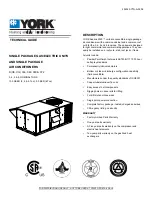
5
English
ITEMS TO BE CHECKED AFTER COMPLETION OF WORK
Items to be checked
If not properly done, what is
likely to occur
Check
Are the indoor and outdoor
units fixed firmly?
Units may drop,vibrate
or make noise
Is the refrigerant leak test
finished?
This may result in insufficient
cooling.
Is the unit fully insulated?
Condensate may drip.
Does the drainage flow
smoothly?
Condensate may drip.
Does the power supply
voltage correspond to that
shown on the name plate?
The unit may malfunction or
the components burn out.
Are the wiring and piping
correct?
The unit may malfunction or
the components burn out.
Is the unit safely grounded?
Incomplete grounding may
result in electric shocks.
Is wiring size according to
specifications?
The unit may malfunction or
the components burn out.
Is something blocking the air
outlet or inlet of either the
indoor or outdoor units?
This may result In insufficient
cooling.
Is the refrigerant piping length
and additional refrigerant
charge documented?
The total refrigerant charge of
the system will not be available
for future reference.
Also review the SAFETY CONSIDERATIONS.
ITEMS TO BE CHECKED AT TIME OF DELIVERY
Items to be checked
Check
Did you hand the operation manual over to your
customer?
Did you explain about operations while s howing
the operation manual to your customer?
Did you explain to your customer how to maintain
and clean local procurements such as the ai r filter,
suction grille, and air outl et grille?
Did you hand manuals of local procurements (in
case equipped) over to your customer?
3.
SELECTING INSTALLATION SITE
•
In cases where the unit is installed in a space where the
humidity may exceed 86°F and 80%RH, reinforce the insu-
lation on the unit body.
Use glass wool or polyethylene foam as insulation to ensure
the thickness is more than 2” and fits inside the installation
space opening.
Select an installation site where the following conditions are ful-
filled and meets with your customer’s approval.
•
Where optimum air distribution can be ensured.
•
Where nothing blocks air passage.
•
Where condensate can be properly drained.
•
Where the supports are strong enough to bear the
indoor unit weight.
•
Where piping between indoor and outdoor units is pos-
sible within the allowable limit. (Refer to the installa-
tion manual for the outdoor unit.)
•
If a return-air duct is not installed, carefully select the
place and method of product installation so that air
flow into the product will not be blocked.
•
When installing this unit in an area that may become
wet (such as crawl spaces), elevate the unit with a
sturdy, non-porous material.
•
Refer to section 4.1 for clearance requirements. Con-
sult all appropriate regulatory codes when determin-
ing final clearance.
4.
INSTALLATION LOCATION
NOTE:
These cased coils are designed for indoor installation
only. The CXTQ**T product line may be installed in upflow or
downflow orientations as shown in Figures 2 and 3.
The unit may be installed in upflow or downflow orientation as
shipped (refer to specific sections for more information).
NOTE:
Condensation may form on the product during COOL
operation. It is recommended to install a secondary drain pan
(field supplied).
If installed above a finished living space, a secondary drain pan
should be installed under the entire unit. The drain pan’s con-
densate line should be routed to a location where the user will
see the condensate discharge. In many regions, the installation
of a secondary drain pan is required by building code. Follow-
ing and adhering to these and all applicable local, state, and/or
national codes is your responsibility as the installer.
In areas where the ambient operating conditions reach above
80%RH, the manufacturer recommends that additional insula-
tion be applied to the outside of the cabinet.
4.1
CLEARANCES
Refrigerant lines must be routed depending upon the configura-
tion of the unit, in order to maintain the required 24” minimum
clearance for service.
In installations that may lead to physical damage (i.e. a garage),
it is advised to install a protective barrier to prevent such dam-
age. Always install units so that a positive slope in condensate
line of 1/100 is allowed.
NOTE:
Furnace application requires that the installer MUST re-
view and strictly follow ALL furnace installation clearance guide-
lines. Failure to do so may result in property/equipment dam-
age, personal injury or death.
CONSULT ALL APPROPRIATE REGULATORY CODES
WHEN DETERMINING FINAL CLEARANCES.






































